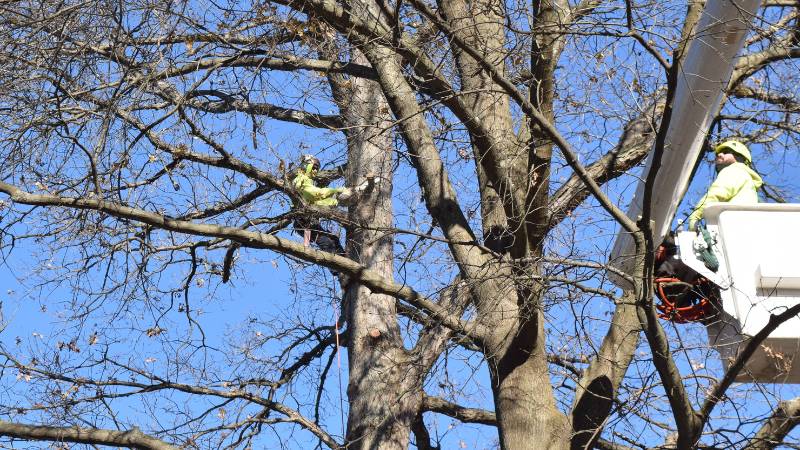You might be thinking that pruning trees in Pennsylvania can only be done during certain times of the year. While it’s true that there are optimal seasons that some people consider the best times to prune, you’ll be relieved to know that trees can be pruned year-round.
In this article, we’ll explore the best times of year to prune a tree in Pennsylvania and debunk the myth that pruning is limited to specific seasons. By understanding the pruning seasons and techniques for different tree types, you’ll be equipped to keep your trees healthy and thriving all year long.
Key Takeaways
- Late fall to early spring is the best time to prune deciduous trees in Pennsylvania.
- Pruning during this time allows for quick healing, reduces the risk of disease or insect infestation, and promotes healthy growth and shape.
- Evergreen trees can also be pruned in the dormant season, while pruning during summer may cause stress to the tree.
- Pruning should be adjusted based on the specific needs of the tree and its natural shape and growth habit.
Understanding the Best Times to Prune in Pennsylvania
If you’re wondering about the best time of year to prune a tree in Pennsylvania, it’s important to understand that trees can actually be pruned year-round. However, there are certain seasons that are more favorable for pruning, depending on the type of tree you have.
In Pennsylvania, the best time to prune deciduous trees is during the late fall, winter, or early spring, before new growth begins. Pruning during this time allows the tree to heal quickly and minimizes the risk of disease or insect infestation.
For evergreen trees, pruning can also be done in early spring, winter, or fall. It’s best to avoid pruning evergreens during the summer months, as they are actively growing, and pruning during this time may cause stress to the tree. Pruning in winter or early spring allows the tree to recover before the warmer months arrive.
It’s important to note that there are exceptions to these general guidelines. Some trees, like flowering trees, may require pruning immediately after they bloom in order to promote new growth for the following year. Additionally, if you notice any dead, diseased, or damaged branches on your tree, it’s best to prune them as soon as possible, regardless of the time of year.

Fall and winter are often considered the best time to prune, but trees can be pruned year-round.
Pruning Techniques for Different Tree Types
Different types of trees require different pruning techniques. Here are four pruning techniques for different tree types:
- Deciduous Trees: These trees lose their leaves in the winter, so the best time to prune them is during their dormant season, which is late fall through early spring. Prune them before new growth starts, as this will promote healthy growth and shape.
- Evergreen Trees: These trees keep their leaves year-round, so you can prune them at any time of the year. However, it is best to avoid pruning in extreme weather conditions, such as during heatwaves or freezing temperatures.
- Flowering Trees: These trees produce beautiful blooms, so it is important to prune them at the right time to avoid cutting off future flowers. Prune them immediately after they finish flowering to ensure you don’t remove the buds for the next season.
- Fruit Trees: Pruning fruit trees is essential for their health and productivity. The best time to prune them is during late winter or early spring while they are still dormant. This allows for proper shaping and removal of dead wood and encourages fruit production.
Remember, proper pruning techniques vary depending on the tree type. By understanding and following these guidelines, you can ensure the health and beauty of your trees all year round.
Factors to Consider Before Pruning
Before pruning, it is important to consider factors such as the tree’s growth pattern, overall health, and desired shape. These factors will help determine the best times to prune your tree in Pennsylvania.
While most trees can be pruned year-round, there are certain times that are more favorable for pruning.
One important factor to consider is the tree’s growth pattern. Some trees, like evergreens, have a slow growth rate and can be pruned at any time of the year. However, for trees with a rapid growth rate, such as fruit trees, it is best to prune them during their dormant season in winter or early spring. This allows the tree to recover and heal before the next growing season.
The overall health of the tree is another crucial factor to consider. If a tree is already weakened or stressed, it is not advisable to prune it. Pruning can further stress the tree and may hinder its ability to recover. It is best to wait until the tree has regained its health before pruning. An exception would be to remove diseased or infected branches through selective pruning.
Lastly, the desired shape of the tree should be taken into account. Pruning can help shape a tree and promote its overall aesthetic appeal. When pruning, it is important to consider the tree’s natural shape and growth habit. Proper pruning techniques should be used to maintain the tree’s structural integrity and prevent damage.
Can Trees Be Pruned Year-Round?
Trees in Pennsylvania can be pruned throughout the year. However, it is important to keep in mind that there are certain factors that may influence the best times to prune a tree. While some trees can be pruned at any time, others may benefit from being pruned during specific seasons.
Pruning during the dormant season, which is typically in late fall through early spring, is often recommended for many tree species. During this time, the tree is not actively growing, which can minimize stress and allow for a quicker recovery. Additionally, pruning during the dormant season allows for better visibility of the tree’s structure, making it easier to identify and remove any dead or diseased branches.
However, not all trees follow the same pruning schedule. Some trees, such as fruit trees, are best pruned in late winter or early spring to promote healthy growth and maximize fruit production. On the other hand, certain species, like maple or birch trees, are better pruned in late summer or early fall to avoid excessive sap bleeding.

Tree pruning should be performed when it’s necessary and not at a specific time of year, particularly if safety is an issue.
Frequently Asked Questions
How often should I prune my trees in Pennsylvania?
Prune your trees in Pennsylvania every 3-5 years to maintain their health and appearance. Regular pruning helps remove dead, damaged, or overgrown branches, ensuring optimal growth and reducing the risk of disease.
Are there any specific regulations or restrictions on tree pruning in Pennsylvania?
Yes, there are regulations on tree pruning in Pennsylvania. Before you start pruning, check with your local municipality or arborist to ensure you follow your area’s specific rules and restrictions.
What are the potential risks or consequences of pruning trees at the wrong time of year?
Pruning trees at the wrong time of year can result in negative consequences. It may weaken the tree’s health, increase susceptibility to diseases and pests, and reduce the tree’s ability to recover from the pruning.
Can I prune my trees myself, or should I hire a professional arborist?
You can prune your trees yourself, but hiring a professional arborist is like having a skilled surgeon operate on you. They have the knowledge and experience to ensure your trees stay healthy and beautiful. They also have the tools, knowledge, and experience to ensure the pruning cuts are made properly.
Are there any specific tree species in Pennsylvania that require special pruning considerations?
Some tree species in Pennsylvania may require special pruning considerations. It is recommended to consult with a professional arborist to determine the specific needs of your trees and ensure proper pruning techniques are used.
Need Tree Pruning in Montgomery and Bucks Counties?
Call Clauser Tree Care today at 215-542-8291. We’ve got the skill and experience to prune any type of tree at any time of year. See why we’re the best tree service company in Pennsylvania!
Proudly service Bucks and Montgomery counties.

About Clauser Tree Care
From who you talk to on the phone in our office, to our courteous and experienced work crews who provide your service, all of the hard-working team members at Clauser Tree Care strive for complete client satisfaction. Our job is simply not done until you are pleased with the experience that you have had working with our company. Founded more than 25 years ago on the principles of honest work and arboricultural best practices, we strive for a higher standard of care for a greener future.







